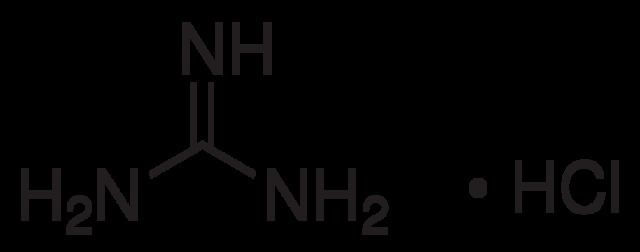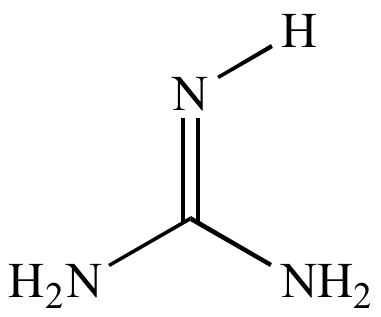Related compounds Molar mass 59.07 g/mol | Formula CH5N3 Melting point 50 °C | |
 | ||
Guanidine
Guanidine is the compound with the formula HNC(NH
2)2. It is a colourless solid that dissolves in polar solvents. It is a strong base that is used in the production of plastics and explosives. It is found in urine as a normal product of protein metabolism. Guanidine is the functional group on the side chain of arginine.
Contents
- Guanidine
- Structure
- Production
- Guanidinium salts
- Industry
- Biochemistry
- Other
- Guanidine derivatives
- References

Structure

Guanidine can be thought of as a nitrogenous analogue of carbonic acid. That is, the C=O group in carbonic acid is replaced by a C=NH group, and each OH is replaced by a NH
2 group. A detailed crystallographic analysis of guanidine was elucidated 148 years after its first synthesis, despite the simplicity of the molecule. In 2013, the positions of the hydrogen atoms and their displacement parameters were accurately determined using single-crystal neutron diffraction.
Production
Guanidine can be obtained from natural sources, being first isolated by Adolph Strecker via the degradation of guanine.

The compound was first synthesized in 1861 by the oxidative degradation of an aromatic natural product, guanine, isolated from Peruvian guano. The commercial route involves a two step process starting with the reaction of dicyandiamide with ammonium salts. Via the intermediacy of biguanidine, this ammonolysis step affords salts of the guanidinium cation (see below). In the second step, the salt is treated with base, such as sodium methoxide.
Guanidinium salts

With a pKb of 0.4, guanidine is a strong base. In neutral water, it exists exclusively as guanidinium (C(NH
2)+
3). Most guanidine derivatives are in fact such salts.
Industry
The main salt of commercial interest is the nitrate [C(NH
2)3]NO
3. It is used as a propellant, for example in air bags.
Biochemistry
Guanidine is protonated in physiological conditions. This conjugate acid is called the guanidinium cation, (C(NH
2)+
3). It is a highly stable +1 cation in aqueous solution due to the efficient resonance stabilization of the charge and efficient solvation by water molecules. As a result, its pKa is 13.6 meaning that guanidine is a very strong base in water.
Guanidinium chloride has chaotropic properties and is used to denature proteins. Guanidine hydrochloride is known to denature proteins with a linear relationship between concentration and free energy of unfolding. In aqueous solutions containing 6 M guanidinium chloride, almost all proteins lose their entire secondary structure and become randomly coiled peptide chains. Guanidinium thiocyanate is also used for its denaturing effect on various biological samples. Guanidine hydrochloride is used as an adjuvant in treatment of botulism, introduced in 1968, but now its role is considered controversial – because in some patients there was no improvement after this drug administration.
Other
Guanidinium hydroxide is the active ingredient in some non-lye hair relaxers.
Guanidine derivatives
Guanidines are a group of organic compounds sharing a common functional group with the general structure (R
1R
2N)(R
3R50−
4. The central bond within this group is that of an imine, and the group is related structurally to amidines and ureas. Examples of guanidines are arginine, triazabicyclodecene, saxitoxin, and creatine.
Galegine is isoamylene guanidine.
